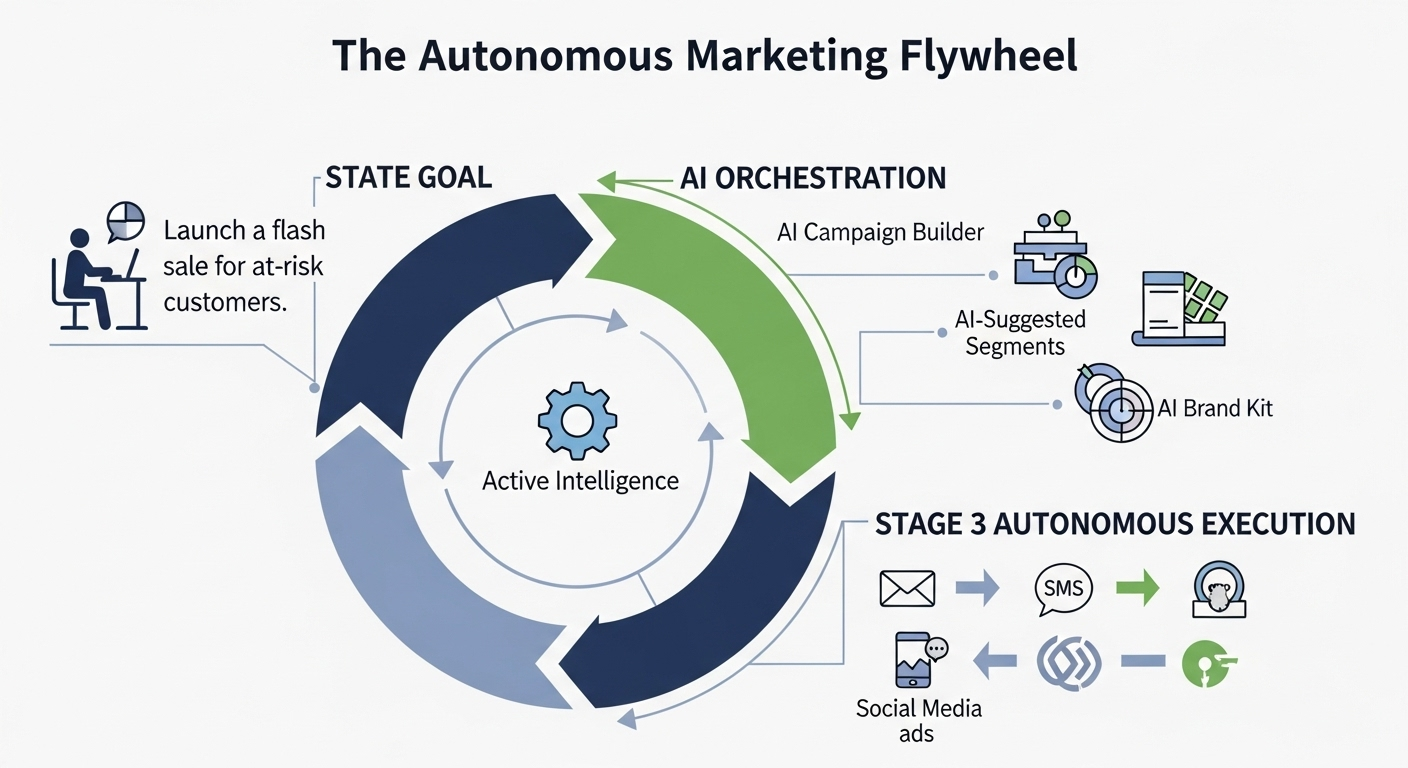The End of the Workflow Era
For years, marketing automation has been defined by a manual, step-by-step paradigm. Marketers painstakingly construct rigid workflows by combining specific triggers, actions, and logic—a time-intensive process requiring constant oversight. This "old way" forces teams to focus on building processes rather than achieving outcomes.
ActiveCampaign is shattering this model with a new paradigm: autonomous marketing. This fundamental shift is powered by Active Intelligence, the platform's system-wide engine. It leverages over 25 specialized AI Agents, each designed to autonomously manage a distinct marketing function, from optimizing send times to predicting customer churn. The result is a system where marketers can simply state a goal, and intelligent agents orchestrate the complex, multi-channel campaign to achieve it. This article serves as a practical guide to the specific tools enabling this shift, showing you how to move from a manual workflow builder to a strategic goal-setter.
Solution 1: From Prompt to Full Campaign in Seconds
Traditionally, building an email campaign was a fragmented, manual slog. Marketers would spend hours writing copy, designing layouts, sourcing stock images, and crafting compelling calls-to-action. Each step was a distinct, time-consuming task that pulled focus away from strategy and onto tedious execution.
ActiveCampaign’s AI Campaign Builder fundamentally changes this process. Instead of building piece by piece, you simply state your objective in a single, plain-language prompt. For example, "Write a welcome email for new subscribers highlighting our key features and offering a 10% discount."
In seconds, the AI generates a complete, ready-to-send campaign. This isn't just a copy draft; it's the entire package: multiple subject line and preheader options, persuasive body copy, a professional layout, relevant imagery, and clear CTAs. The system handles the tedious assembly, delivering a fully-formed campaign aligned with your goal.
This approach combines AI-driven speed with human oversight. The generated campaign serves as a powerful first draft, which you can then quickly review, edit, and refine to match your brand's unique voice. You maintain full creative control, but the initial heavy lifting is done for you, transforming hours of work into minutes of strategic refinement.

Solution 2: Intelligent Audience & Brand Automation
Autonomous marketing extends beyond campaign creation to intelligently manage your audience and brand identity. Previously, segmentation required marketers to manually build complex rules to filter contacts. ActiveCampaign’s AI-Suggested Segments agent eliminates this guesswork. It proactively analyzes customer data—purchase history, engagement, and website activity—to automatically surface high-impact groups like "potential loyalists," "at-risk subscribers," or "likely to buy again." Instead of searching for opportunities, the platform brings them directly to you.
Brand consistency was another manual chore, demanding teams to repeatedly input hex codes, fonts, and logos. The AI Brand Kit agent automates this entirely. Simply provide your website URL, and the AI instantly extracts your logo, color palette, and typography to create a reusable brand profile. This ensures every email and landing page is perfectly on-brand with a single click.
The YMCA of Alexandria leveraged these tools to transform their marketing. By using AI to identify key segments and instantly apply branding, they achieved a 12.8% click-through rate—far exceeding the 2% nonprofit industry average—and saved over 10 hours of manual work per week. The AI Brand Kit, in particular, made it "super easy" to maintain a consistent identity across all communications, freeing the team to focus on strategy instead of tedious setup.
The Engine and The Ecosystem: Active Intelligence & MCP
The engine driving this autonomy is Active Intelligence. It is not a single feature but a system-wide intelligence layer that learns from your specific business data—contacts, engagement patterns, and campaign results. This foundational context makes the platform’s AI Agents "goal-aware," enabling them to act on your unique objectives within the Active Intelligence Workspace, a central hub for managing these autonomous functions.
To extend this intelligence beyond the platform, ActiveCampaign developed the Model Context Protocol (MCP). This protocol allows external AI tools, such as Claude Desktop or Cursor, to connect directly and securely to your account. The practical outcome is profound: a simple prompt in a third-party application can now automatically update contact records, pull real-time campaign performance metrics, or trigger automation workflows without ever leaving that interface.
This marks a significant departure from traditional, developer-focused APIs that require custom coding and manual integration. The MCP instead facilitates a conversational, deeply integrated ecosystem where intelligence flows seamlessly between platforms, creating a truly autonomous marketing environment.
Conclusion: The Marketer as Strategist, Not Technician
The era of painstakingly building step-by-step workflows is over. The fundamental shift is clear: instead of constructing rigid processes, marketers now simply state a goal and let autonomous agents manage the execution. Tools like the AI Campaign Builder, which generates entire campaigns from a single prompt, and the Model Context Protocol (MCP), which integrates external AI, are the catalysts for this transformation. They eliminate the tedious, technical work of campaign assembly and orchestration.
This elevates the marketer from a technical operator to a high-level strategist. The focus is no longer on the "how" but on the "what" and "why." The expert’s role is now to set ambitious goals, define the creative vision, and interpret results to guide future strategy. A team of autonomous AI agents handles the complex, multi-channel orchestration, freeing human talent to focus on what it does best. The future of marketing is not about connecting boxes, but about directing intelligence.
